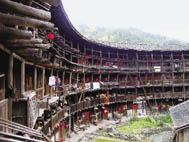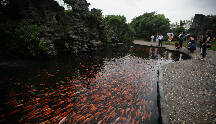Tulou, Fujian
Their concern for defense made the Hakkas pay special attention to the thickness of their walls, usually building them one to two meters thick, and many experts have concluded that the tulous were specifically defensive in nature.
One exceptional example is Yuchang Lou, in Nanjing County, which remains sturdy despite the ravages of time. Built 700 years ago, not a single pillar supporting the building remains straight, and all the wooden structures lean left or right, with the largest inclination reaching 15 degrees. It looks as if it would collapse with a gust of wind, and visitors usually walk with the greatest of care. Locals are more accustomed, and walk with ease.
According to 55-year-old Liu Chunwei, the current owner of the compound, the inclination is due to the deviation between the footing of the wall and the wooden structures. The wall is 18 meters tall, and tapers from its base to the top, but the wooden structures do not taper. As a result, all the pillars are inclined. Nevertheless, the pillars on top and those on the first floor are lined up along the same axis, without any shifting of the center of gravity, much like a stack of chairs in an acrobatic display – even though the chairs are piled up one upon the other in different directions, the center of gravity remains constant.
Yuchang Lou has been able to stand for more than 700 years because of its thick walls of rammed earth, which support the building's main weight, while the pillars only support the floorboard. After visiting Yuchang Lou, an Italian expert commented that the 700-year-old structure was a miracle of engineering.
Life in an Earthen House
The Hakkas live in compact communities, and all the dwellers in the tulou are kin, so it is common that all belong to the same clan. As a common saying goes, if one family is drying grain in the sun and a rainstorm comes, everyone lends a helping hand.
During Spring Festival, a door-to-door collection would be organized to buy spring couplets, each family donating several yuan to decorate the earthen houses. According to Hakka tradition, all those who leave to find work must return home for a family reunion on the eve of Spring Festival. Their knowledge and experience are highly valued, and it is their responsibility to treat the entire clan in the ancestral temple. Each family contributes a jug of wine and a dish, and all members of the clan get together to share their experiences.
|
|
| Yuchang Lou, the unique architecture among Fujian's earthen compounds, characterized by its leaning wooden structures. |
More than 60 tulous are scattered about the hilly land in Hua'an County. Eryi Lou, Nanyang Lou and Dongyang Lou, which are among the largest, are an important part of the bid for Fujian's tulous to be designated as a World Cultural Heritage site. The 200-year-old Eryi Lou, known as the "king of the tulou," comprises more than 400,000 tiles. It differs from other earthen houses in that it is a combination of Chinese and Western architectural styles.
In an eclectic display, Eryi Lou boasts 952 murals; the ceilings of its rooms are pasted with pages of the New York Times, circa 1931, and semi-nude images of Indian goddesses and painted clocks with Roman numerals can also be found on the lintels of doors, testifying to the cosmopolitanism of the original house owner, who was a returned overseas Chinese.
Services
Economy
- Eco-agriculture and Eco-tourism Power Nanchang’s Green Development
- Balance Environmental Protection and Economic Prosperity – Nanchang Looks to European Technology for Green Development
- Sustainable Growth Requires Wiser Energy Use
- Chinese Economy: On the Path of Scientific Development
- China's Economy over the Last Ten Years


